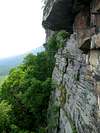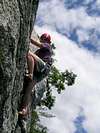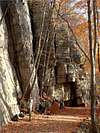|
|
Area/Range |
|---|---|
|
|
41.67586°N / 74.35804°W |
|
|
Hiking, Trad Climbing, Sport Climbing, Toprope, Bouldering, Ice Climbing, Scrambling |
|
|
Spring, Summer, Fall, Winter |
|
|
2289 ft / 698 m |
|
|
Overview
The Shawangunk Mountains (pronounced shawn-gum), located between the Catskill Mountains and the Hudson River and 90 miles north of New York City, 10 miles east of Kerhonkson and 6 miles west of New Paltz. The Shawangunks are one of the most extensive climbing areas in the east, even with its problems with over crowding and erosion. Featuring four main cliffs with a multitude of classic routes ranging from beginner class (4.0) to expert class (5.13), the rock is noted for its solid quality, horizontal holds, good cracks, and overhangs.The main climbing areas are the Trapps, Near Trapps, Millbrook, Peters Kill and Skytop (Skytop is completely closed due to insurance problems). Within these areas there is over a 1,200 ascent routes to choose from. The range of difficulty in the Gunk’s vary from Goldner's Grunge (Trapps) at class 4.0 to Pumping Pygmies (Skytop) and The Zone (Trapps) at class 5.13.
There are so many different routes that purchasing the book “Gunks Guide” by Todd Swain (Author) is a must for the novice to the area. The Gunks are known more for there classic rock climbing but there are also over 85 miles of hiking trails throughout the escarpment. There is also some good scrambles in the area.
The rock type in the Gunks is quartzite.
History
Wiesener noticed the line of cliffs in the early 1930's. Hans Kraus who worked on President Kennedy's back and suggested the rocking chair to President Kennedy was an early climber and was the first to do High Exposure. Transistor Nobel physisist, Shockley, first climbed Shockley's Ceiling 5.8 in the 1950s. A well known Vulgarian was the first to do a nude ascent here and this has since become a "right of passage" in the area. John Stannard climbed Foops, the first well-known U.S 5.11 here. Henry Barber reconstructed the crux of Foops in his basement and emerged in the spring to make the second ascent of it. Barbara Devine made the first woman's ascent of Foops.Getting There
If traveling by car from the NYC area you’ll want to take Exit 18 off the NYS Thruway (I-87). Turn left on Route 299 (Main Street) continue through New Paltz. After six miles west of new Paltz you’ll come to a "T" at Route 44/55, make a right here which will lead you toward all of the cliffs and boulders. There are signs from New Paltz which say “Mohonk Preserve” along this whole route. If this is your first visit go one half mile to the Mohonk Preserve Visitor Center on the right hand side of the road. You can get guidebooks, fill up water bottles, get info and passes here. If you proceed 1.3 miles from the 299-44/55 intersection you will come to the West Trapps Trailhead. Walk to the end of the lot and get on the West Trapps Connector. Take this to Trapps Bridge then go left and get on Undercliff Road—this carriage road goes under all of the climbs in the Trapps. This is the most convenient trailhead for climbing with a really short stroll to the Trapps or Near Trapps. If this lot is full, you can park at the Mohonk Preserve Visitors Center Parking Lot, or the Wawarsing Parking and take the East Trapps Connector Trail (often called the stairmaster) which brings you to the base of the Trapps.Red Tape
Over the decades as climbers have blazed new trails and mapped and quantified over 1,200 ascent routes, battles have raged over access, style and control. In an effort to find the best way to set standards, the Mohonk Preserve sponsored a series of contentious meetings where the different factions argued over the issues. Ultimately, this led to the Preserve issuing a series of guidelines and rules governing access and climbing on the Preserve:1. No new bolts or pitons may be placed, except to replace those installed prior to November, 1986. When replacing a bolt, every effort must be made to use the existing hole.
2. Chipping or improving holds is forbidden, as is rock trundling.
3. Cutting or removing trees is forbidden.
4. Climbing and/or rappelling instruction or guiding is regulated in New York State, and even more strictly controlled on Preserve land. On the Preserve this includes scout groups, schools, college groups, camps, church groups, professional guides, et cetera. Any group planning to instruct climbing on the Preserve needs to contact the Preserve prior to their trip. A copy of the guiding policy can be obtained from the Preserve.
5. The Preserve recommends the use of natural colored webbing when left as retreat or rappel slings.
6. It is also recommended that if chalk is used, it is of a color natural to the area.
7. Fires and high impact camping are not allowed on the Preserve or Hotel grounds.
The Mohonk Preserve requires all climbers to either become annual climbing members ($85 a year) or to purchase day permits ($6.00 weekdays, $8.00 weekends) These can be purchased from the Mohonk Preserve staff that are stationed at the Visitor Center, parking lot entrances, or from patrolling rangers out on the property. It's worth arriving early, especially on spring and autumn weekends, since other folks will have the same idea, and parking is available for “only” 450 cars. Climbing on weekends at the Trapps requires you to communicate and be courteous with others who share the place with you. It’s a bit like climbing in Europe, definitely not a wilderness experience but lots of fun! The Trapps is the most popular cliff, with climbs ranging in height from 30 to 225 feet. There’s lots of variety to be found here—both in grades and route styles. Also quite popular is the Near Trapps, located just west of the Trapps. Millbrook is much less visited, and requires a longer hike to get to.
Camping or Related Establishments
Local Hostels, Bed and BreakfastsNEW PALTZ HOSTEL
Camping Sites
LAZY RIVER CAMPING
HIDDEN VALLEY LAKE
CREEK VIEW CAMP SITES
227 Creek Locks rd.
Rosendale, NY 12472
845-658-9142
Near Trapps
There’s 16 camping site's that’s located on the west side of the Trapps Bridge known as Trapps Camp (aka Camp Slime). This facility is available only for climbers, and is very convenient. When you enter the campsite there is an information board which details all the info you need to use the place.This facility is maintained by the Mohonk Preserve and is the only camping allowed on Preserve property.
NY State DEC Multi-Use
This area is located on Route 299 just 1/2 mile from Rt 44/55 in Gardiner. It is free to camp here, however, there are are no ammenities or reservations. For more info and regulations about this area please contact the Department of Environmental Conservation at the address below.
DEC Regional Office
South Putt Corners Road
New Paltz, NY 12561
845-256-3024
The Trapps - Section
Under ConstructionDue to the accessibility and the numerous amounts of climbs The Trapps cliff is by far the most popular cliff to climb on. The cliffs range from 30-200 feet in height and about two miles long. A little more than half way up the cliff is the GT “Grand Traverse” Ledge. The ledge stretches from East overhang to Emilietta, with intermittent breaks. Running at the base of The Trapps cliff is Undercliff Road, this is an old carriage road built in 1903.
See The Trapps Route for route information
Near Trapps - Section
Under ConstructionThe second most popular cliff to climb to the Gunks is The Near Trapps. The routes can vary from 60-170 feet in height; rock on either end is of good quality but is loose and dirty near the middle section.
See The Near Trapps Route for route information
Millbrook - Section
Under ConstructionClimbing in Minnewaska is totally illegal, except in certain specified areas, and Millbrook isn't one of them. Depending upon which surveyor you hire, the cliff face either is owned by the landholders at the base of the cliff or owned by Minnewaska at the top of the cliff. In either case, if you climb Millbrook and place your hand on the top of the cliff you are subject to fine, arrest and imprisonment as ownership of that is totally unquestioned, it is owned by the State.
Skytop - Section
Under ConstructionLiability Concerns Keep SkyTop Off Limits to Climbers.
Gear
The Gunks requires a full arsenal of trad gear. When heading to the area, be sure to have a full set of stoppers and/or Hexentrics, Camalots, Slings, and Biners. You willl be protecting horizontal cracks and gear such as Camalots, Stoppers, TCUs and Tri-cams all work well.On many routes you wil find fixed pitons, slings, nuts and bolts, but keep in mind that these tend to weaken with age and remember use them with care. A 60m rope is strongly recommended. Another option is to use a Double-Rope set up, as you will be navigating tricky overhangs and meandering lines.
A Typical Gunk Rack consists of a normal selection of small to medium sized Stoppers and Hexs, RP nuts, smaller Tricams, a full set of Friends, QuickDraws, extra biners and a few long slings. A great majority of the climbs work well with a 60 meter rope.
Weather
The best seasons to climb the Gunks are spring and fall. The summer is pleasant but the months of July and August can get pretty hot and humid.By far, my most favorite time is during the Autumn months. The colors are awesome and the temps couldn't be more pleasant.
External Links
- Seneca Rocks
Sister crag to the Gunks
- John Bragg
Did lots of climbs at the Gunks










dillme - Jul 17, 2009 3:18 pm - Hasn't voted
Creekview CampsitesHI, I am one of the owners at Creekview Campsites and our phone number is listed wrong. Our phone number is 845-658-9142. Rockclimbers are always welcome at our campground! We have both men and womens bathrooms with showers and each site has picnic table and fire ring. Thanks!
birdny - Jul 19, 2009 9:18 pm - Voted 10/10
Re: Creekview CampsitesThanks, I have corrected the phone number.